How to Patch for Future Pavement Preservation
BY AsphaltPro Staff
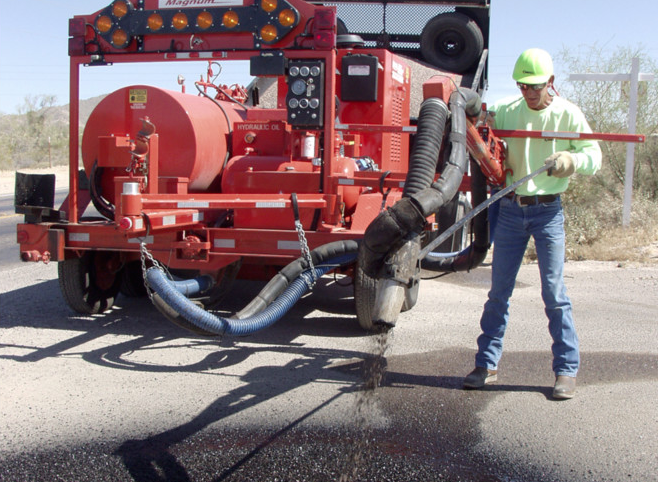
Patching is an important process in any pavement maintenance program. We have the ability to significantly increase the life of our patches if we pay attention to industry best practices.
As with any other maintenance procedure, it’s important to make these repairs early.
“There are fortunes to be saved just by changing a philosophy to just go fill potholes while they’re small,” said Scott Yasinski, vice president of sales with SuperiorRoads Solutions. “There’s no such thing as a pothole too small to worry about. A 4-inch pothole on a busy street can be a foot in diameter in just a few days.”
There should be more behind your pavement maintenance strategy than a throw-n-go mentality. That sort of thinking leads to pothole repairs that are gone the next day. Here’s how to perform a patch that lasts.
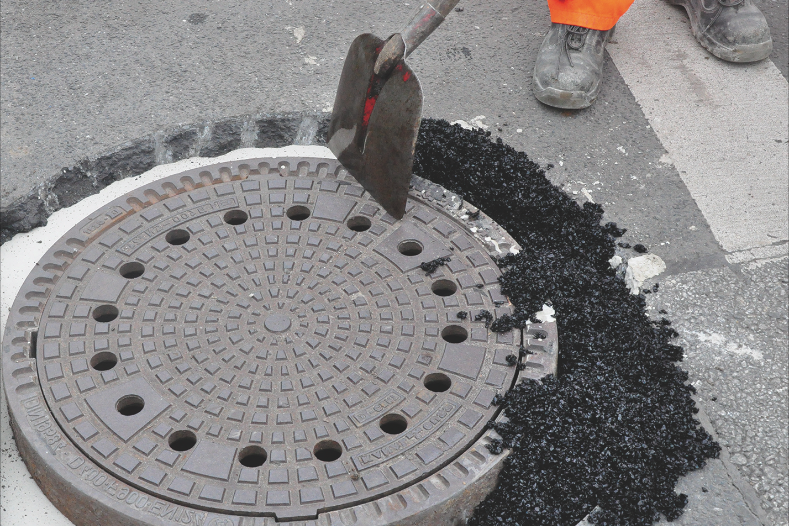
Whether you’re performing a saw cut and replace or an infrared patch, using the right material is key. When it comes to selecting a cold patch mix, Main said it’s important to pay attention to how stiff the cold patch mix is and to look out for uncoated aggregate. Photo courtesy of GemSeal Pavement Products.
Choose the Right Mix
Whether you’re performing a saw cut and replace or an infrared patch, using the right material is key.
“The type of material can be the deciding factor in whether your repairs last 2 years or 20 years,” said Aaron Barla at KM International. For surface repairs like pothole patching and skin patches, he recommends using a top mix, which can offer better compaction, less water penetration and a smoother patch than a base mix. “Typically the finer the material the better, especially when doing maintenance.”
It’s also important to keep that mix at the proper temperature until you’re ready to use it. “We see many maintenance contractors buying 3 or 4 tons of mix just to keep 2 tons warm,” Barla said. In addition to maintaining the temperature hot throughout the working day, using a hotbox reclaimer allows you the ability to reclaim or reheat bulk stored virgin material overnight, can save time traveling to and from the hot mix plant and can help contractors more closely monitor the temperature of their asphalt. “The contractor can buy what they need and use what they buy, eliminating the need to throw excess material away.”
In some circumstances, contractors might need to perform a cold patch using cold mix. Although some agencies believe patches with hot mix are more permanent, patches with cold mix can be a quick temporary solution. Selecting your cold patching material is an important part of the process.
“In North America, contractors’ only options are to buy cold mix from an asphalt supplier or order bagged cold mix,” Yasinski said.
According to Rob Main, general manager of cold mix products at GemSeal Pavement Products, some cold mixes are considered permanent and can stay in the pothole for years. To find a high quality cold mix, Main said it’s important to pay attention to how stiff the cold patch mix is and to look out for uncoated aggregate.
“A well-made cold mix will have a thin film of asphalt covering every stone in the mix uniformly,” he said. “If that film starts to separate from the aggregate, you’re at risk of a failure.
“I recommend a simple visual test to look for uncoated stones where you can see the natural color through the black asphalt coating,” Main continued. “The asphalt is the binder that holds everything in place in the pot hole, and if you see these telltale signs that it’s separating from the aggregate, the mix probably isn’t a very good one.” He also recommends putting a small amount of cold mix asphalt in a cup, pouring water on it, and seeing if any binder comes off the stone.
“This test is performed to see if the binder will stay on the stone while it is stock piled over the next few months,” Main said. “If the piles of cold mix are left uncovered, the binder can wash or bleed off the aggregate. The quality of the binder and aggregates is an important part of the cold mix production process.”
Another special consideration to make when performing cold patches is the application temperature. “In my experience, cold mix is best applied when it’s close to the temperature it was mixed at, so around 185 degrees,” Yasinski said. “I’ve tried applying it at 100 degrees and at 180 degrees, and the patch at 180 degrees was much better.”
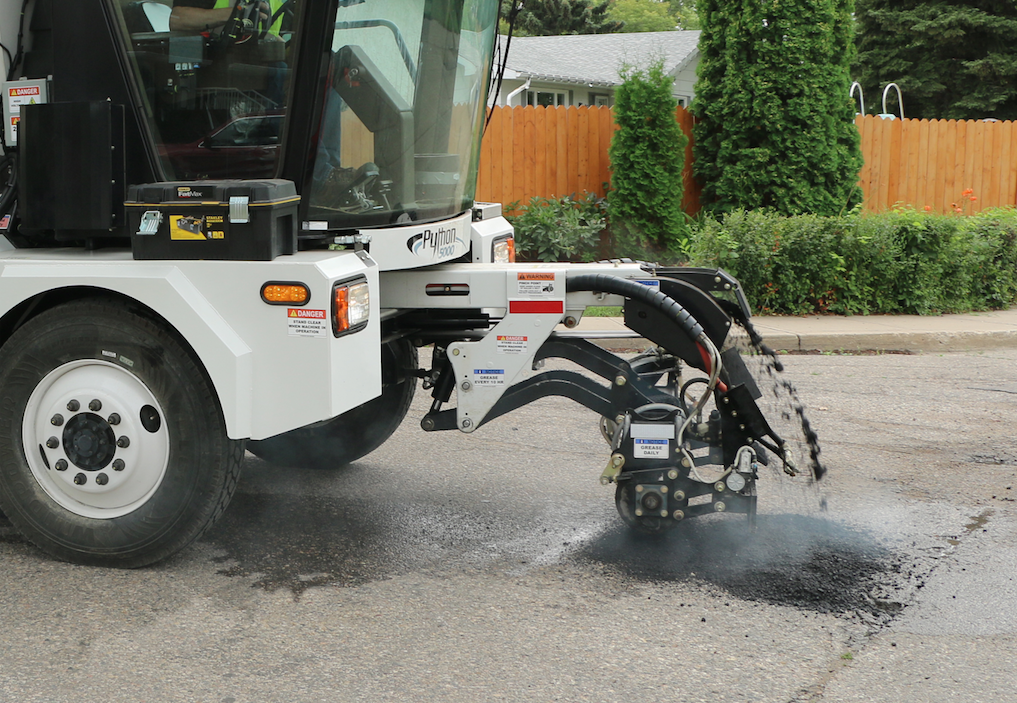
With SuperiorRoad’s Python 5000 pothole patcher, the operator can complete each step of the process without leaving the cab. “The operator drives the machine up to the hole, blows it with air blasts of 120 PSI,” Yaskinski said. “The second stage is the application of tack oil.” The hopper will heat the material, which is then augered onto the belt and delivered into the hole. The operator can then rake the mix for even distribution and then compact with the Python 5000, which offers the same force as a 1-ton roller. Photo courtesy of SuperiorRoads Solutions.
Make It Stick
Regardless of the solution you use, adhesion is vital to the longevity of any patch. That involves sound cleaning practices, the use of tack in many instances, and successful compaction.
“The biggest mistakes we see are not cleaning the hole effectively and not getting compaction,” Yasinski said. “When I watch conventional road crews clean a pothole, they’re limited to what they’re able to achieve with the tools they have. A brush or broom can’t clean the pothole effectively, or their pressure system isn’t strong enough.”
It’s important to follow best practices for cleaning to get maximum adhesion. Depending on the patching process you use, you may need to spray a tack coat.
Compaction is also key. “When it comes to compacting asphalt, it doesn’t matter how the patch was made,” said Darrell Engle of Atlas Copco. “Whether it’s a cut-and-fill or infrared method, the compaction technique is the same.”
Engle said compaction does vary when you need to compact base materials that were replaced or added during the cut-and-fill method. “For this scenario you’ll need to compact the soil using a plate compactor or roller without water,” he said. “The base will also likely need to meet different compaction requirements than asphalt, so it’s important to keep that in mind for optimal quality.”
It’s also important to ensure you have the right tool for the job.
“I’ve seen some people compact the area by stomping on it or leaving traffic to do the job,” Yasinski said. “A very small percent of manual repairs have a tamper out there and have the equipment to compact properly.”
SuperiorRoad’s all-in-one pothole patcher, the Python 5000, for example, offers the same force as a 1-ton roller to remove the air voids in the pothole. “Creating contact with the entire road surface is important for maximum adhesion,” Yasinski said.
“We usually give a good, better, best scenario,” KMI’s Barla said. “Good is a vibratory plate compactor, better is single drum roller, best is a double drum ride-on roller.”
As you begin compacting the patch, Engle recommends starting with edge pinching to seal the patch, “which is compacting 3 inches of asphalt around the edge of the area with a plate compactor,” and then compacting the rest of the patch.
“The edges are the most likely failure point so you want to ensure you are compacting at the hottest point,” Barla said.
“One of the most important things to keep in mind, regardless of whether you are using a plate compactor or asphalt roller, is keeping your water reservoirs full,” Engle said. “This ensures there is plenty of water coverage on the plate or roller drum so you do not pick up any asphalt from the patch, which not only makes a mess on your equipment but also affects the quality and smoothness of the asphalt.”
Engle said it’s also important to check stiffness readings often. “This lets the operator know that the entire area has been adequately compacted, which will provide optimal longevity.”

Spray injection patching cleans, tacks, fills and compacts in one continuous operation. The process requires a one- or two-person crew, can be used in cool or damp conditions, and doesn’t require a roller. Photo courtesy of Crafco Inc.
The Spray Injection Patching Process
Another surface treatment is spray injection patching. Spray injection patching cleans, tacks, fills and compacts in one continuous operation. The process requires a one- or two-person crew, can be used in cool or damp conditions, and doesn’t require a roller, making spray patching a fast and lasting repair option according to Brandi Julian, sales training manager at Crafco Inc.
Depending on the type of repair, spray patching provides the ability to patch and repair large potholes, construction joints, alligatored areas and broken shoulder edges.
Although Julian reports spray injection repairs lasting up to 3 years, it’s always important to follow best practices to get that longevity. As with any other patching option, it’s important to clean the surface.
In the case of spray injection patching, Julian recommends lowering the nozzle to 12 inches to blow dust, dirt and standing water away from the repair area and keeping the hose as straight as possible for best performance.
She also recommends using tack, with the nozzle at 24 to 30 inches from the pavement. “Be sure to coat the entire area including 6 inches past the edge of the repair for best performance,” Julian said. “Highly distressed areas and damp areas require heavier tack application.”
Next, you’ll fill the hole by continuously moving the nozzle over the repair from the deepest areas to the shallowest areas, taking care to avoid material build-up.
“Emulsion is the glue. To get a long lasting repair, make sure you have enough emulsion,” Julian said. “If an excess of emulsion appears, reduce the emulsion flow. If the stone appears undercoated increase the emulsion flow.” When the stone and emulsion flow are adjusted properly, Julian said less than 10 percent of the stone should look uncoated.
Because spray patching is self-compacting, Julian said, the last step is applying the topcoat. “Lightly coat over the entire repair with dry stone to complete the repair,” Julian said. She also suggests sweeping any overspray of material back onto the repair area with a push broom to finish with a clean, aesthetic patch.
The Infrared Repair Process
Infrared repair can be used for a variety of asphalt imperfections, Barla said, adding that infrared is most effectively used for surface repairs on a single lift. “If a contractor did want to offer infrared for a sub base failure, they should let the customer know in that situation they are only giving them a temporary repair and may have to be repaired again in the future,” he added.
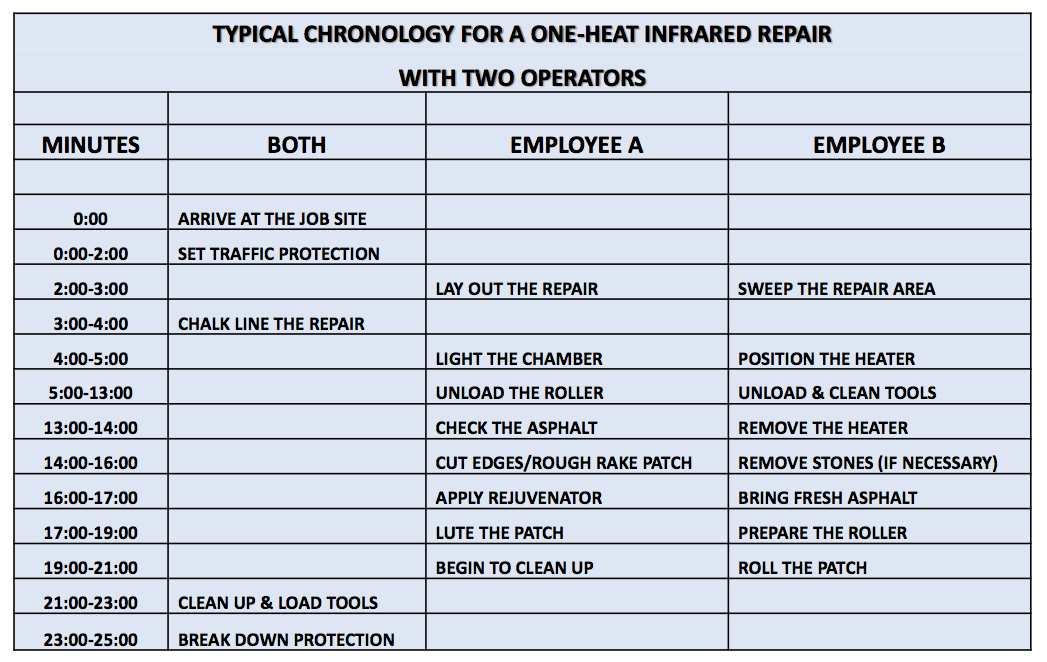
Source: KASI Infrared Corporation
“If the surface of the asphalt shows major deformity, the sub grade has probably been affected,” said Bob Kieswetter of Heat Design Equipment Inc.
However, for single lifts not showing major deformities, infrared can offer a long-lasting patch.
According to Tom Allen, general manager of KASI Infrared Corporation, the first step is to mark off the repair area. Next, Kieswetter said, you need to clean the area, preferably using an air compressor to blow all loose material away from the patch area, and remove any crack filler material with a router.
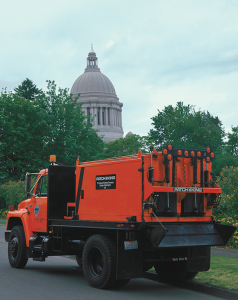
The Patch King from Process Heating Company, Seattle, offers a way to keep material hot throughout the day—and overnight—and then an augered chute that swings side to side to deliver material to the area to be patched. Photo courtesy of PHCo.
After cleaning the area, place your infrared heater over the patch. All edges of the repair area should be at least 6 inches from the damaged area, and the heater should be able to heat an additional 6 inches beyond the repair area to ensure the restored area is fused to the existing hot pavement when rolled, Allen said.
“The most common mistake we see in dong infrared repair work is the edge of the patch is cut too close to the unheated asphalt so there’s not a seamless watertight joint,” Kieswetter said.
Heat as slowly as necessary to avoid burning the existing asphalt. The time required to heat the area will depend on how old the asphalt is, if it contains any moisture, and the weather in which you are working. Dirt can also be a barrier to heat. To reach the required depth, you may need to remove the top layer of existing asphalt.
Next, Kieswetter recommends moving the heater and cutting the edge of the patch in straight lines a minimum of 3 inches inside the heated area.
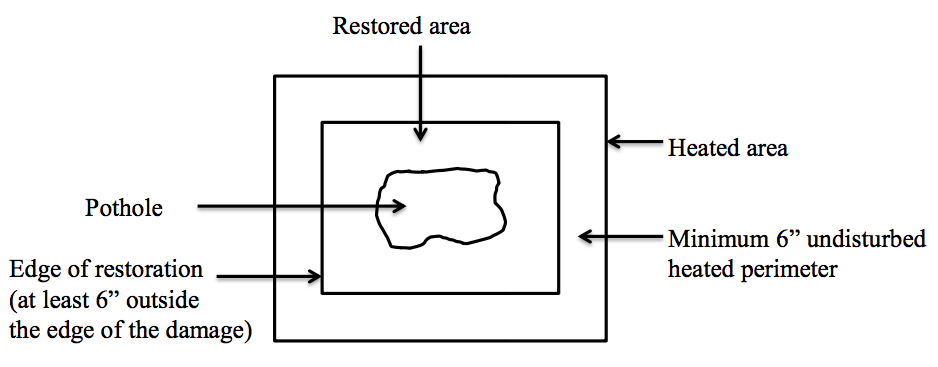
Make sure the infrared chamber is positioned properly over the repair. The repair area should be squared off, insuring that all edges are at least 6 inches away from the damage. Then, you need to add an additional 6-inch perimeter that can be heated, but is left undisturbed. According to Tom Allen, general manager of KASI Infrared Corporation, this will ensure that he new asphalt will fuse to the existing roadway, eliminating any seam.
“The key to infrared is you are creating a hot-to-hot bond between the new and existing asphalt,” Barla said. “So when you start defining the edges, you want to go in about 3 inches from the edge of the heated area to ensure that hot-to-hot bond.”
Then you must thoroughly scarify the top layer. Kieswetter reminds readers that scarifying to the full depth of the heated layer is one of the most important steps to ensure high-quality results. “That’s one of the most common mistakes we see, not scarifying deep enough to penetrate the full surface course,” he said.
Using a lute, make the area level and remove any coarse material to ensure a uniform surface texture. Next, you must add a rejuvenator.
“One of the biggest mistakes we see on infrared repair jobs is not using a rejuvenating agent,” Barla said. “Most of the time when one is doing an infrared repair, the asphalt is 15 to 20 years old, so over time the asphalt has oxidized. That rejuvenating agent replenishes the maltenes the asphalt has lost over the years.”
Barla recommends spraying a heavy mist around the edges of the repair. “If you are ever questioning yourself about the amount of rejuvenator you are using, overdo it rather than under do it,” Barla said.
Next, add sufficient new, hot asphalt to meet the job’s grade requirements and mix it in with the existing material before using a lute to level out, Allen said.
“Another common mistake is using asphalt that has gotten too cold for compaction,” Kieswetter said. Using a hotbox, as mentioned above, can help solve this problem.
As with any patch, it’s important to compact the edges first and then the interior, ensuring a uniform compaction throughout the repair.
How to Patch Patchwork-Style Lots
At the height of the recession, Krystal Strassman remembers doing more than 30 patches on a single apartment complex parking lot. The $50,000, 1.5-day job required 300 tons of asphalt to improve the 40-year-old lot.
“People were so shy about spending money back then,” said Strassman, project estimator and marketing director for DRS Paving and Asphalt Reheat Systems in Fitchburg, Wisconsin. “The customer might rack up $50,000 in patches, but that’s a lot less than the couple hundred thousand it would cost to fix the whole thing.”
Despite improvements in the overall economic climate, you might still be faced with a similar situation.
“We have some clients who invest so heavily in patches because they don’t want to have to shut down their lot,” Strassman said. Gas stations and fast food restaurants that operate 24 hours and require a parking lot as part of their business are still patching lots religiously to avoid lost business. “It isn’t cheap for us to come back a bunch of times and set up and tear down over and over, but to them, what’s most important is not being closed.”
Or, maybe you have a customer with a deteriorating lot and an extremely tight budget. Either way, you might be faced with the challenge of performing a whole lot of patches in a very small area.
Here are Strassman’s tried and true tips for a top-notch patch (and patch, and patch, and patch) job.
The Due Diligence of Proper Drainage
To ensure the highest quality results, Strassman visited the lot almost a dozen times—often after it rained—to mark out areas that needed to be patched, as well as how the lot was draining. That level of due diligence made it easier to convince the customer exactly why they needed each patch.
The original scope of the project included only superficial issues, so it took some education to convince the customer about the dangers of poor drainage.
“There was some concern that we were taking too much asphalt out, but we knew we had to do it to make the lot drain,” she said. She had to consider how each patch was going to affect the lot’s drainage and anticipate future problems.
“Sometimes you have to take out good asphalt—maybe 3 or 4 feet beyond the part that looks terrible,” she said. “Otherwise, you’re just pushing puddles around, and that’s not good for anyone.”
The first time Strassman went to the lot, she marked the areas that needed to be patched in orange. Then, she’d go back after it rained to mark out how the water was draining and ponding in green paint.
Strassman also recommends no less than a 6-foot level to effectively measure elevations, as well as a transit level. “A 4-foot level won’t let you see what you need to see, and you can’t eyeball everything,” she said.
Keep Eager Drivers At Bay
Despite patching as an opportunity to minimize lot closures, working with traffic moving around you is never easy.
One time, Strassman’s crew was paving in a McDonald’s parking lot when a driver drove right over the freshly laid, uncompacted mat, despite all the signs, equipment and safety cones.
“He drove right up to the paver and asked us what we were doing,” Strassman said. Although situations like this don’t happen very often, when working in commercial lots with heavy traffic, it’s important to devote proper resources to traffic control.
In the case of the 30-patch parking lot, the DRS crew went to the jobsite early to prepare it before patching began. “If the crew isn’t there, it’s easy for people to move the cones and park in the middle of where you need to be working,” Strassman said. “People are a lot more inclined to stay away from an area if people are actually working there.”
Of course, signage like, “DRS trucks only beyond this point,” ward off most drivers, but Strassman also recommends putting one crewmember on traffic control.
“Just do it,” she said. “It keeps the crew happy so they don’t have to focus on everyone else or worry about being interrupted to talk to people. It’s the best $15 an hour I’ve ever spent.”
Get Results, Manage Expectations
In the end, DRS’s commitment to the project—and the results it achieved—paid off. “After that job, three other apartment complexes asked me to do the same for their lots,” Strassman said.
However, she also stresses the importance of being honest if patching isn’t the answer.
“I’ll tell people directly, ‘I can’t patch this,’” she said. “You have to be careful to not oversell patching. The customer needs to know they aren’t getting a brand new lot.”
